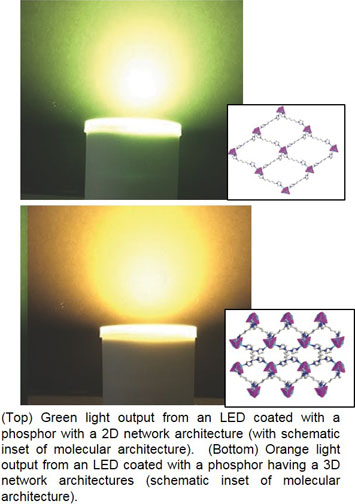Nanostructured Phosphors Make Bright LEDs Without Rare-Earth Elements
July 31, 2018
What is the scientific achievement?
CFN users from Rutgers University designed a family of rare-earth-element free phosphors with high quantum efficiency and exceptional photostability. Their network nanoarchitecture provides wavelength tunability. Combined improvements in efficiency and stability were achieved by combining strongly emissive molecular clusters with selected organic ligands through strong Cu-N bonds.
Why does this achievement matter?
The excellent performance, stability, and low-cost processing of these compounds make them ideal alternatives to rare-earth-element based phosphors for general light applications. The new synthesis approach provides a framework for designing next generation phosphors.
What are the details?
Rare-earth element-based phosphors are used in the LEDs that dominate the current lighting market, raising the cost and making LEDs susceptible to supply risks. Nanomaterials such as nanocrystals, quantum dots and metal organic frameworks all show promise as alternatives to rare-earth element-based phosphors. However, low efficiency and stability, together with complicated materials synthesis and device fabrication procedures are remaining drawbacks limiting practical applications of these nanomaterial solutions. In this study, we developed a rare-earth element-free phosphor family with both exceptional quantum efficiency and stability, together with solution-based processability. We show that by introducing network structures through Cu-N bonds, the thermal stability of high emissive Cu4I4 cluster is greatly improved. The temperature-dependent time-resolved photoluminescence study indicates thermally activated process contributed to the emission mechanisms of a few phosphors in this family. The excellent optical performance and framework stability, coupled with low-cost, solution-based fabrication process, make these network-structured hybrid phosphors ideal as alternatives to rare-earth element-based phosphors for general lighting applications.
CFN Capabilities
The CFN Advanced Optical Spectroscopy and Microscopy facility was used for photoluminescence characterization.
Publication Reference
Fang, Y., Liu, W., Teat, S. J., Dey, G., Shen, Z., An, L., Yu, D., Wang, L., O’Carroll, D. M. & Li, J., A Systematic Approach to Achieving High Performance Hybrid Lighting Phosphors with Excellent Thermal- and Photostability. Advanced Functional Materials 27, 1603444 (2017).
https://doi.org/10.1002/adfm.201603444
Acknowledgement of Support
Financial support from the National Science Foundation (Grant No. DMR-1507210) is gratefully acknowledged. The Advanced Light Source (ALS) was supported by the Director, Office of Science, Office of Basic Energy Science, of the U.S. Department of Energy, under contract DE-AC02-05CH11231. The temperature-dependent photoluminescence lifetime measurements were performed at the Center for Functional Nanomaterials, which is a U.S. DOE Office of Science Facility at Brookhaven National Laboratory under Contract No. DE-SC0012704.
2018-13098 | INT/EXT | Newsroom










